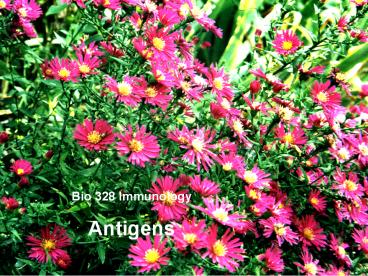Bio 328 Immunology - PowerPoint PPT Presentation
1 / 45
Title: Bio 328 Immunology
1
Bio 328 Immunology Antigens
2
- Antigens
- Immunogenicity vs. antigenicity
- Factors that influence immunogenicity
- Factors of the immunogen
- Factors of the biological system
- Adjuvants
- Epitopes
- B-cell epitopes
- T-cell epitopes
- Haptens
- Superantigen
- Mitogens
3
B cell activation Competency signal (1) and (2)
and Proliferation signal (3)
4
- Factors that influence immunogenicity
- Properties of the immunogen
- Foreignness
- Molecular size
- Chemical complexity
- Susceptibility to Ag processing
- Properties of the biological system
- Genotype of the recipient
- Dosage and route of administration
- Adjuvants
5
(No Transcript)
6
(No Transcript)
7
(No Transcript)
8
(No Transcript)
9
Alum Al NH4 (SO4)2 . 12 H2O
(Crystals puncture lysosome and trigger formation
of the inflammasome)
10
Muramyl-dipeptide
(Recognized by NLRs)
11
(No Transcript)
12
B cell activation Competency signal (1) and (2)
and Proliferation signal (3)
13
Karl Landsteiner (1868-1943) ABO blood group
system Rhesus factor Polio virus Haptens
specificity of Ag-Ab interactions 1930 Noble
Medicine
14
(No Transcript)
15
(No Transcript)
16
(No Transcript)
17
(No Transcript)
18
(No Transcript)
19
(No Transcript)
20
- Epitopes
- Properties of B-cell epitopes.
- Size of the B-cell epitope
- Nature of the Ag-binding site of the antibody
- Hydrophilic groups on the protein surface
- Sequential or non-sequential amino acids
- Located in flexible regions
- Multiple, overlapping B-cell epitopes
21
Inhibition of dextran-anti-dextran interaction by
glucose oligomers.
22
Antigen the octapeptide Angiotensin II
Antibody (Fab)
23
Protruding glutamine
Hen egg lysozyme (green/red) recognized by the
anti-HEL antibody (L chain yellow, H chain blue).
24
(No Transcript)
25
(No Transcript)
26
(No Transcript)
27
(No Transcript)
28
Sperm whale myoglobin five sequential epitopes.
29
Non-sequential epitope of lysozyme Red contact
with LC Blue contact HC White contact with LC
and HC
30
(No Transcript)
31
(No Transcript)
32
(No Transcript)
33
- Epitopes
- Properties of T-cell epitopes.
- T-cell epitopes are protein fragments
- T-cell epitopes are presented by MHC molecules
- The MHC molecule can present various oligomeric
epitopes - T-cell epitopes are often internal
- T-cell epitopes are always sequential
- The dominance of T-cell epitopes is determined in
part by the set of MHC molecules expressed by the
individual
34
(No Transcript)
35
(No Transcript)
36
B cell epitope
37
Immunogenicity depends on MHC binding.
38
(No Transcript)
39
(No Transcript)
40
(No Transcript)
41
(No Transcript)
42
(No Transcript)
43
(No Transcript)
44
(No Transcript)
45
The End































